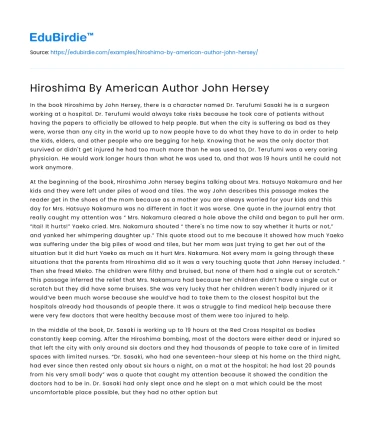Introduction
John Hersey's "Hiroshima" stands as a seminal piece of journalistic literature, shedding light on the immediate and enduring impacts of the atomic bomb dropped on Hiroshima on August 6, 1945. Published in 1946 in a special edition of The New Yorker, Hersey's work was groundbreaking in its narrative approach, offering a detailed account of the experiences of six survivors. As a pioneering example of new journalism, "Hiroshima" blends factual reporting with literary storytelling, providing a human face to the harrowing statistics of war. This essay aims to explore the multifaceted impact of Hersey's work, its reception among contemporary audiences, and the ethical considerations it raises. Through an examination of Hersey's narrative techniques and the broader implications of his work, we gain insight into the historical and moral dimensions of the atomic age. By analyzing these elements, we can appreciate the enduring significance of "Hiroshima" in both literature and history.
Narrative Techniques and Literary Significance
Hersey's "Hiroshima" revolutionized the way stories of war and suffering were told by incorporating a narrative style that was both immersive and meticulously detailed. The text stands out for its use of novelistic techniques in a journalistic framework, which allowed Hersey to convey the personal and emotional experiences of the survivors. By focusing on six individuals—each with unique backgrounds and responses to the disaster—Hersey was able to present a multifaceted view of the tragedy. This approach not only humanized the victims but also made the abstract horror of nuclear war tangible to readers. Hersey's narrative begins with the mundane activities of the protagonists, such as Dr. Masakazu Fujii enjoying a morning cup of tea, which are abruptly disrupted by the bombing. This juxtaposition serves to emphasize the sudden and total devastation brought by the atomic bomb.
Save your time!
We can take care of your essay
- Proper editing and formatting
- Free revision, title page, and bibliography
- Flexible prices and money-back guarantee
The employment of detailed and emotive descriptions in "Hiroshima" functions to bridge the gap between distant events and personal experience. Hersey's use of direct quotes and vivid imagery, such as describing the "noiseless flash" that preceded the explosion, allows readers to vicariously experience the event. According to Hersey, "The people of Hiroshima were being given a lesson in the fragility of life," a sentiment that resonates deeply throughout the narrative. Furthermore, Hersey's use of an unbiased tone, devoid of overt political commentary, ensures that the story remains focused on the human condition rather than ideological debates. This stylistic choice underscores the universal impact of war, transcending national boundaries and appealing to a collective human conscience.
Reception and Ethical Considerations
Upon its publication, "Hiroshima" was met with widespread acclaim and served as a catalyst for public discourse on the ethical implications of nuclear warfare. The article's publication in The New Yorker marked a departure from the magazine's usual content, demonstrating the gravity and urgency of Hersey's message. Readers were confronted with a stark portrayal of the consequences of the atomic bomb, prompting discussions about the morality of its use. Hersey's work was instrumental in shifting public opinion, as it provided a platform for the victims’ voices, traditionally marginalized in mainstream narratives dominated by military and political perspectives.
Critics, however, have raised questions about the ethical dimensions of Hersey's work, particularly concerning the representation of suffering. Some argue that the focus on individual stories might inadvertently obscure the broader geopolitical dynamics at play. Others contend that Hersey's detached narrative style risks desensitizing readers to the enormity of the tragedy. Despite these critiques, many scholars maintain that Hersey’s work is invaluable for its uncompromising portrayal of human resilience and vulnerability. As historian Paul Boyer notes, "Hersey's Hiroshima made the bombings human and real in a way that statistics and official reports never could."
Legacy and Continued Relevance
The legacy of Hersey's "Hiroshima" extends far beyond its initial publication, influencing both literature and historical discourse on nuclear warfare. The work has been incorporated into educational curricula worldwide, serving as a vital tool for teaching about the human costs of war. Its narrative style has inspired countless journalists and authors, paving the way for immersive storytelling in reporting. Hersey's emphasis on individual experiences has become a cornerstone for understanding the broader implications of historical events, prompting readers to consider the personal dimensions of global conflicts.
Moreover, "Hiroshima" remains relevant today as discussions about nuclear disarmament and non-proliferation continue. The work serves as a potent reminder of the catastrophic consequences of nuclear weapons, urging contemporary audiences to reflect on the ethical responsibilities of scientific and technological advancements. Hersey's portrayal of the survivors' endurance and hope also offers a message of resilience in the face of adversity, resonating with readers facing modern-day challenges.
Conclusion
John Hersey's "Hiroshima" transcends its immediate historical context, offering a powerful exploration of human suffering and resilience in the wake of unimaginable destruction. Through his innovative narrative techniques and unwavering focus on the personal stories of survivors, Hersey provides a poignant reminder of the ethical complexities surrounding nuclear warfare. The work's enduring impact on literature and public consciousness underscores its significance as a vital document of the atomic age. As we continue to grapple with the implications of technological advancements, "Hiroshima" challenges us to reflect on our shared humanity and the moral imperatives that guide our actions. In doing so, Hersey's work remains a crucial touchstone for understanding the past and navigating the future.






 Stuck on your essay?
Stuck on your essay?

